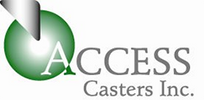Maintain Caster Wheels
Is your platform cart, towline or other material handling equipment failing to work properly? Are you unsure of what’s causing the problem? The answer to your troubles could be quite simple: nine times out of 10, worn-out caster wheels are at fault. A quick visual inspection can pinpoint the problem. If the wheels are worn or rougher in some areas than others, replacing them should correct the problem. Are you curious as to how you can prevent the problem before it starts? Here are some best practices for preventative care for stainless steel casters and caster wheels:
1. Check Fasteners
Manufacturers recommend inspecting the wheel frames and fasteners periodically to make sure that nothing is amiss. Turn your equipment on its side so that you can closely examine it to check for broken deck boards or welds, loose bolts or nuts, distorted framework or unsteady expanding applicators. Fix any problems before using the equipment to prevent further damage to the wheels or other components.
2. Inspect Wheels
Review the wheel surface to check for any signs of visible tread wear. Is there a flat spot? This is typically a sign of foreign material accumulation, a seeming benign matter such as thread, hair or string can easily cause the wheel to bind and create a flat spot. Are your rubber tires badly worn? It’s imperative to replace them promptly to prevent floor damage, load shifting and steering problems.
3. Lubricate Grease Fittings
Develop and stick to a consistent lubrication schedule. Under standard working conditions, grease fittings need to be lubricated every six months. However, if used in a corrosive or wet application it may be necessary to lubricate the fitting more often.
Have any other questions about your stainless steel casters? Contact the manufacturer with any questions for more guidance and care tips.


